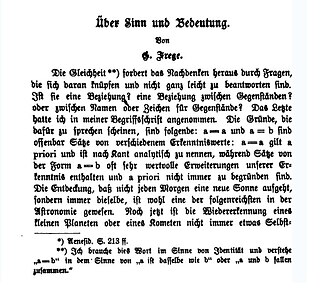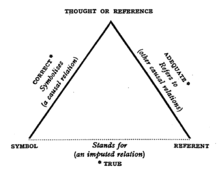In the philosophy of language, a proper name – examples include a name of a specific person or place – is a name which ordinarily is taken to uniquely identify its referent in the world. As such it presents particular challenges for theories of meaning, and it has become a central problem in analytic philosophy. The common-sense view was originally formulated by John Stuart Mill in A System of Logic (1843), where he defines it as "a word that answers the purpose of showing what thing it is that we are talking about but not of telling anything about it". This view was criticized when philosophers applied principles of formal logic to linguistic propositions. Gottlob Frege pointed out that proper names may apply to imaginary or nonexistent entities, without becoming meaningless, and he showed that sometimes more than one proper name may identify the same entity without having the same sense, so that the phrase "Homer believed the morning star was the evening star" could be meaningful and not tautological in spite of the fact that the morning star and the evening star identifies the same referent. This example became known as Frege's puzzle and is a central issue in the theory of proper names.
In linguistics and grammar, a pronoun is a word or a group of words that one may substitute for a noun or noun phrase.

Semantics is the study of linguistic meaning. It examines what meaning is, how words get their meaning, and how the meaning of a complex expression depends on its parts. Part of this process involves the distinction between sense and reference. Sense is given by the ideas and concepts associated with an expression while reference is the object to which an expression points. Semantics contrasts with syntax, which studies the rules that dictate how to create grammatically correct sentences, and pragmatics, which investigates how people use language in communication.

In the philosophy of language, the distinction between sense and reference was an idea of the German philosopher and mathematician Gottlob Frege in 1892, reflecting the two ways he believed a singular term may have meaning.
In linguistics and philosophy, the denotation of an expression is its literal meaning. For instance, the English word "warm" denotes the property of having high temperature. Denotation is contrasted with other aspects of meaning including connotation. For instance, the word "warm" may evoke calmness or coziness, but these associations are not part of the word's denotation. Similarly, an expression's denotation is separate from pragmatic inferences it may trigger. For instance, describing something as "warm" often implicates that it is not hot, but this is once again not part of the word's denotation.
A causal theory of reference or historical chain theory of reference is a theory of how terms acquire specific referents based on evidence. Such theories have been used to describe many referring terms, particularly logical terms, proper names, and natural kind terms. In the case of names, for example, a causal theory of reference typically involves the following claims:

Phosphorus is the god of the planet Venus in its appearance as the Morning Star. Another Greek name for the Morning Star is "Eosphorus", which means "dawn-bringer". The term "eosphorus" is sometimes met in English. As an adjective, the word "phosphorus" is applied in the sense of "light-bringing" and "torch-bearing" as an epithet of several gods and goddesses, especially of Hecate but also of Artemis/Diana and Hephaestus. Seasonally, Venus is the "light bringer" in the northern hemisphere, appearing most brightly in December, signalling the "rebirth" of longer days as winter wanes.
In linguistics, anaphora is the use of an expression whose interpretation depends upon another expression in context. In a narrower sense, anaphora is the use of an expression that depends specifically upon an antecedent expression and thus is contrasted with cataphora, which is the use of an expression that depends upon a postcedent expression. The anaphoric (referring) term is called an anaphor. For example, in the sentence Sally arrived, but nobody saw her, the pronoun her is an anaphor, referring back to the antecedent Sally. In the sentence Before her arrival, nobody saw Sally, the pronoun her refers forward to the postcedent Sally, so her is now a cataphor. Usually, an anaphoric expression is a pro-form or some other kind of deictic expression. Both anaphora and cataphora are species of endophora, referring to something mentioned elsewhere in a dialog or text.
David Benjamin Kaplan is an American philosopher. He is the Hans Reichenbach Professor of Scientific Philosophy at the UCLA Department of Philosophy. His philosophical work focuses on the philosophy of language, logic, metaphysics, epistemology and the philosophy of Frege and Russell. He is best known for his work on demonstratives, propositions, and reference in intensional contexts. He was elected a Fellow of the American Academy of Arts & Sciences in 1983 and a Corresponding Fellow of the British Academy in 2007.
In linguistics, coreference, sometimes written co-reference, occurs when two or more expressions refer to the same person or thing; they have the same referent. For example, in Bill said Alice would arrive soon, and she did, the words Alice and she refer to the same person.
A referent is a person or thing to which a name – a linguistic expression or other symbol – refers. For example, in the sentence Mary saw me, the referent of the word Mary is the particular person called Mary who is being spoken of, while the referent of the word me is the person uttering the sentence.
A referential theory of meaning is a theory of language that claims that the meaning of a word or expression lies in what it points out in the world. Ex, The word tree may have an exterior meaning from the one always intended, that is, tree can be translated into different form of meaning .The object denoted by a word is called its referent. Criticisms of this position are often associated with Ludwig Wittgenstein.
The symbol grounding problem is a concept in the fields of artificial intelligence, cognitive science, philosophy of mind, and semantics. It addresses the challenge of connecting symbols, such as words or abstract representations, to the real-world objects or concepts they refer to. In essence, it is about how symbols acquire meaning in a way that is tied to the physical world. It is concerned with how it is that words get their meanings, and hence is closely related to the problem of what meaning itself really is. The problem of meaning is in turn related to the problem of how it is that mental states are meaningful, and hence to the problem of consciousness: what is the connection between certain physical systems and the contents of subjective experiences.
In the philosophy of language, the descriptivist theory of proper names is the view that the meaning or semantic content of a proper name is identical to the descriptions associated with it by speakers, while their referents are determined to be the objects that satisfy these descriptions. Bertrand Russell and Gottlob Frege have both been associated with the descriptivist theory, which is sometimes called the mediated reference theory or Frege–Russell view.
In philosophy—more specifically, in its sub-fields semantics, semiotics, philosophy of language, metaphysics, and metasemantics—meaning "is a relationship between two sorts of things: signs and the kinds of things they intend, express, or signify".
A truth-bearer is an entity that is said to be either true or false and nothing else. The thesis that some things are true while others are false has led to different theories about the nature of these entities. Since there is divergence of opinion on the matter, the term truth-bearer is used to be neutral among the various theories. Truth-bearer candidates include propositions, sentences, sentence-tokens, statements, beliefs, thoughts, intuitions, utterances, and judgements but different authors exclude one or more of these, deny their existence, argue that they are true only in a derivative sense, assert or assume that the terms are synonymous, or seek to avoid addressing their distinction or do not clarify it.
Frege's puzzles are puzzles about the semantics of proper names, although related puzzles also arise in the case of indexicals. Gottlob Frege (1848–1925) introduced the puzzle at the beginning of his article "Über Sinn und Bedeutung" in 1892 in one of the most influential articles in analytic philosophy and philosophy of language.
In analytic philosophy, philosophy of language investigates the nature of language and the relations between language, language users, and the world. Investigations may include inquiry into the nature of meaning, intentionality, reference, the constitution of sentences, concepts, learning, and thought.

Naming and Necessity is a 1980 book with the transcript of three lectures, given by the philosopher Saul Kripke, at Princeton University in 1970, in which he dealt with the debates of proper names in the philosophy of language. The transcript was brought out originally in 1972 in Semantics of Natural Language, edited by Donald Davidson and Gilbert Harman. Among analytic philosophers, Naming and Necessity is widely considered one of the most important philosophical works of the twentieth century.
Logophoricity is a phenomenon of binding relation that may employ a morphologically different set of anaphoric forms, in the context where the referent is an entity whose speech, thoughts, or feelings are being reported. This entity may or may not be distant from the discourse, but the referent must reside in a clause external to the one in which the logophor resides. The specially-formed anaphors that are morphologically distinct from the typical pronouns of a language are known as logophoric pronouns, originally coined by the linguist Claude Hagège. The linguistic importance of logophoricity is its capability to do away with ambiguity as to who is being referred to. A crucial element of logophoricity is the logophoric context, defined as the environment where use of logophoric pronouns is possible. Several syntactic and semantic accounts have been suggested. While some languages may not be purely logophoric, logophoric context may still be found in those languages; in those cases, it is common to find that in the place where logophoric pronouns would typically occur, non-clause-bounded reflexive pronouns appear instead.




